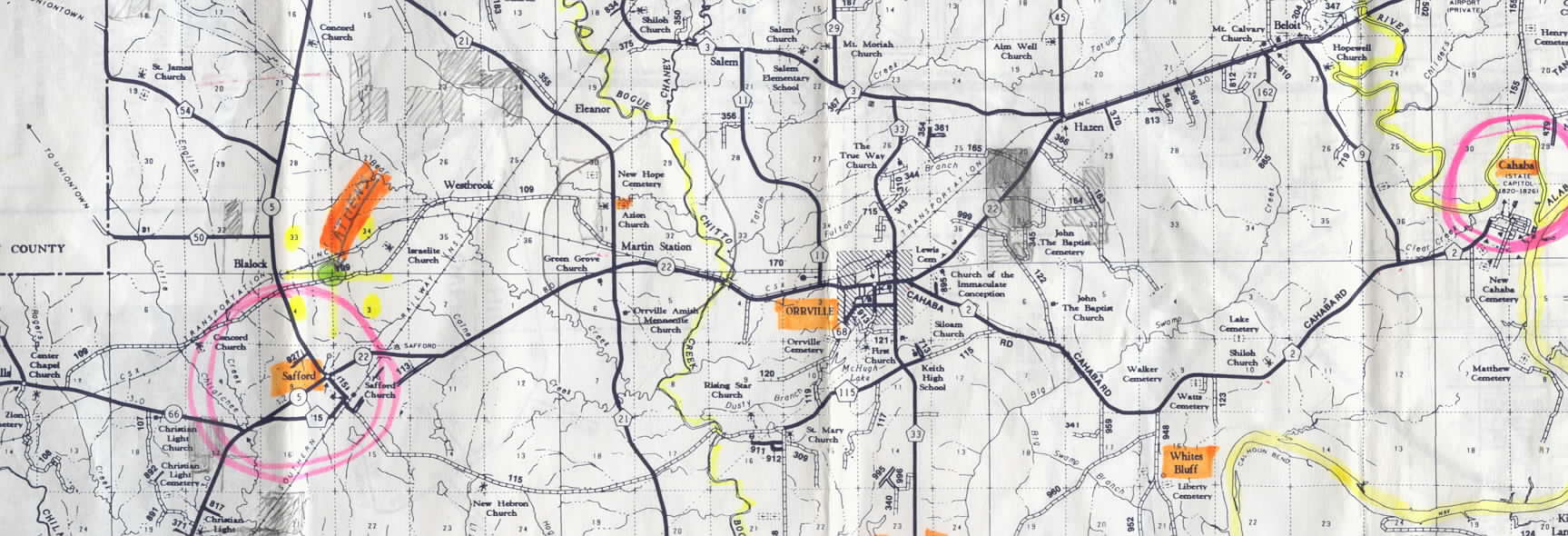
If you want to take a highly recommended side-tour to Cahaba, turn leftonto Dallco (Dallas Co.) Rt. 9 and go about three miles south to its end.Turn left again onto Dallco Rt. 2 and follow it east about a mile and ahalf to the park entrance. To continue on your trip to Athens, you caneither retrace your route back to 22 and continue on 22 west (slightlylonger from Cahaba) or you can take the slightly shorter route, stayingon DallcoRt. 2 east until it rejoins 22 just east of Orrville.
Regardless, continue west on 22. Not quite three miles west of Orrville,you'll come to Dallco Rt. 21. Turn right (north) here, at Martin's Station,and after you cross the railroad tracks about a quarter of a mile later,be watching on the left for the old wooden St. Luke's Episcopal Church.Right beside it is a much newer, white, cinderblock Baptist church. Turnin here and park. St. Luke's is the historic old church that was builtin Cahaba and later moved to its present site. Ms. Linda Derry, Directorof the Cahaba Preservation Project, is working to raise funds to move itBACK to Cahaba--and we wish her the greatest speed and success in thisendeavor! (Click here to go to thewebsite for this project.) Across the road from where you parked,hidden in the trees and brush, is the old cemetery for the original chuch.I don't know the name of this church, but I feel sure it (1) was a ProtesantMethodist church, (2) burned or was otherwise destroyed, (3) it was replacedwith the St. Luke's building which either had already been abandonedas Cahaba lay dying or was about to be abandoned and its congregation soldit to replace the destroyed Protestant Methodist church, and (4) was inor very near Athens.
Here is my reasoning for these four statements.
Isom Gwin, my gg-granduncle, is buried in the cemetery across the road.
To me, this means he was a member of whatever church was adjacent tothis cemetery at the time of his death.
On his tombstone and in his obituary, it states that he was a memberof the Protestant Methodist church.
We know that he died in 1853, some 23 years before the St. Luke's buildingwas moved to its present site in 1876.
His obituary also states that he died at his home 16 miles west ofCahaba.
Documents which he signed as a justice of the peace prove that he livedin Athens.
The 1850 Dallas Co. census lists him in Athens.
After his death, his executors sold his land lying in the town of Athens.
An old Dallas Co. map someone showed me shows Athens at the junctureof sections 33 and 34 (of Township 16 Range 7) and sections 3 and 4 (ofTownship 15 Range 7).
I have shown this juncture in green on the map below, labeled in orange.
 | ||